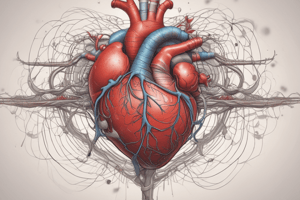Podcast
Questions and Answers
The heart functions as a ______ pump, which ensures efficient circulation of blood.
The heart functions as a ______ pump, which ensures efficient circulation of blood.
double
The heart's structure is designed to optimize ______ through the cardiovascular system.
The heart's structure is designed to optimize ______ through the cardiovascular system.
blood flow
Deoxygenated blood from the body enters the ______ atrium.
Deoxygenated blood from the body enters the ______ atrium.
right
______ artery disease is a common cardiovascular disease.
______ artery disease is a common cardiovascular disease.
Oxygen-poor blood from the body returns to the heart via ______.
Oxygen-poor blood from the body returns to the heart via ______.
Oxygen-rich blood from the lungs flows into the heart through ______ veins.
Oxygen-rich blood from the lungs flows into the heart through ______ veins.
Oxygenated blood received from the lungs enters the ______ atrium.
Oxygenated blood received from the lungs enters the ______ atrium.
Arteries are the primary carriers of ______ blood away from the heart.
Arteries are the primary carriers of ______ blood away from the heart.
The ______ valve allows blood to exit the heart into the aorta.
The ______ valve allows blood to exit the heart into the aorta.
Capillaries are tiny vessels that facilitate the exchange of oxygen, nutrients, and ______ between the bloodstream and surrounding tissues.
Capillaries are tiny vessels that facilitate the exchange of oxygen, nutrients, and ______ between the bloodstream and surrounding tissues.
Maintaining a balanced diet and engaging in regular ______ can help reduce the risk of cardiovascular diseases.
Maintaining a balanced diet and engaging in regular ______ can help reduce the risk of cardiovascular diseases.
The walls of blood vessels are composed of layers of connective tissue, muscle, and ______ fibers, providing strength and flexibility.
The walls of blood vessels are composed of layers of connective tissue, muscle, and ______ fibers, providing strength and flexibility.
Flashcards are hidden until you start studying
Study Notes
Understanding the Cardiovascular System: Heart Function, Diseases, Anatomy, Circulation, and Blood Vessels
Heart Function
At the core of the cardiovascular system lies the heart, a muscular organ responsible for pumping blood throughout the body. Comprised of four chambers—two atria and two ventricles—the heart functions as a double pump, which ensures efficient circulation of blood. Deoxygenated blood from the body enters the right atrium, passes through the tricuspid valve into the right ventricle, and is propelled out of the heart via the pulmonary valve into the pulmonary artery. Next, the oxygenated blood received from the lungs enters the left atrium, traverses the bicuspid (mitral) valve into the left ventricle, and exits the heart through the aortic valve into the aorta. This continuous cycle enables the delivery of oxygen and nutrients to all organs and tissues and the removal of waste products.
Cardiovascular Diseases
Several conditions can impact the cardiovascular system, leading to various health complications. Some common cardiovascular diseases include coronary artery disease, heart attack, high blood pressure, and stroke. These diseases often arise from factors such as poor lifestyle choices, genetics, or environmental factors. It's crucial to maintain a balanced diet, engage in regular exercise, monitor blood pressure and cholesterol levels, and avoid smoking and excessive alcohol consumption to reduce the risk of developing cardiovascular diseases.
Heart Anatomy
Hearts vary in size depending on gender, body weight, and overall health status. While the average heart weighs approximately 8-12 ounces, the size and shape can differ due to individual variations. The heart's structure is designed to optimize blood flow through the cardiovascular system, with each component contributing to maintaining proper circulation.
Blood Circulation
Blood circulation is facilitated by a network of blood vessels that include arteries, veins, and capillaries. The cardiovascular system operates as a closed loop, ensuring that blood is continually cycled through the heart and delivered to the rest of the body. Oxygen-poor blood from the body returns to the heart via veins, while oxygen-rich blood from the lungs flows into the heart through pulmonary veins. The heart then distributes oxygen-rich blood via arteries to various tissues and organs, while deoxygenated blood travels back to the heart via veins for reoxygenation.
Blood Vessels
Blood vessels serve as the highway for blood transport throughout the body. Arteries are the primary carriers of oxygenated blood away from the heart, while veins convey deoxygenated blood toward the heart. Capillaries are tiny vessels that facilitate the exchange of oxygen, nutrients, and waste between the bloodstream and surrounding tissues. The walls of blood vessels are composed of layers of connective tissue, muscle, and elastic fibers, providing strength and flexibility to accommodate changes in blood pressure and volume.
Studying That Suits You
Use AI to generate personalized quizzes and flashcards to suit your learning preferences.




